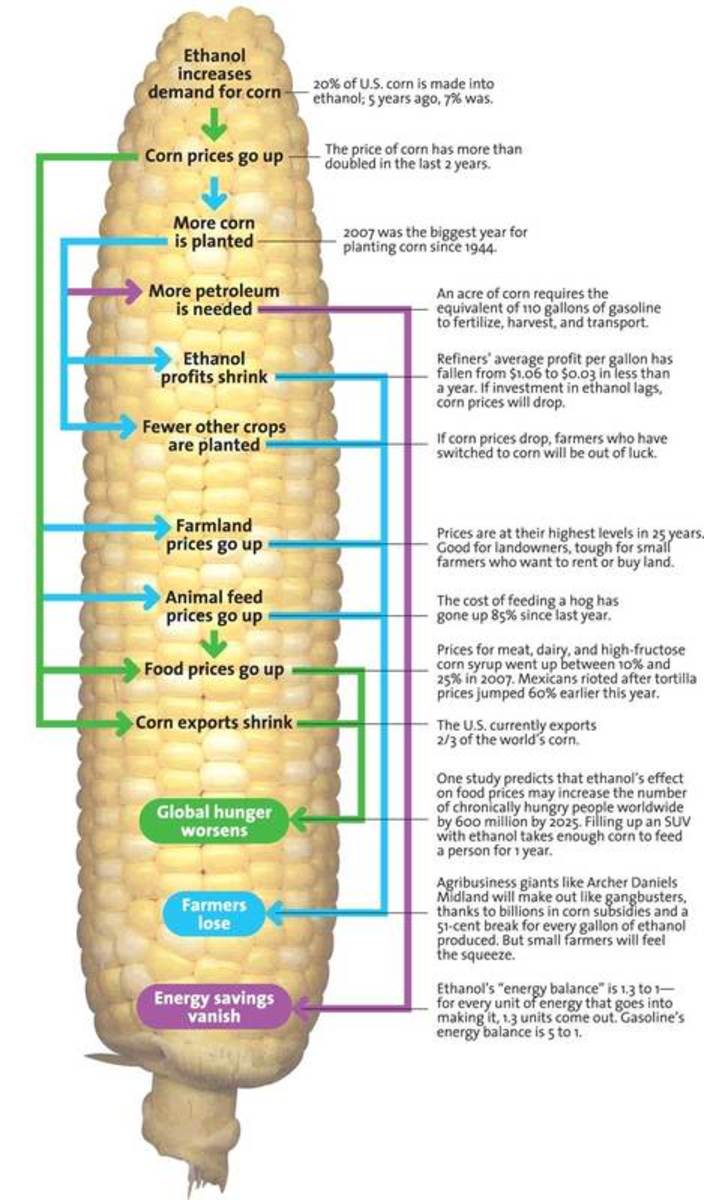Making Fuel from Cellulose – A Promising Future
Cellulosic Ethanol – A Magical Biofuel
Due to the rapid rate of depletion of our natural reserves of oil and natural gas, various government agencies and private industries are struggling hard to invent technologies which can convert cellulosic material into motor fuels, in a cost effective manner. Cellulose has been made the target as; it is the most abundant organic compound present on our planet Earth. It forms the structural component of all the green plants. It is rich in glucose, which can be easily converted to sugars and fermented to produce “cellulosic ethanol” – the magical Biofuel. And above all, if we are able to produce this biofuel at a reasonable cost and meet the demands of the entire world, it can act a renewable source of energy, as it is synthesized from never ending raw materials like, non-edible parts of plants, grasses, wood, miscanthus, sugarcane bagasse, sorted municipal waste, etc.
Technology behind Cellulosic Conversion
Even though the conversion of cellulose into sugars and fermentation into ethanol (biofuel) looks to be simple on board, we have to cross many hurdles before we are able to device a user-friendly technology which can convert cellulose into cellulosic ethanol. Currently, cellulose conversion technologies have been broadly classified into two categories, which are, thermal and biochemical (enzyme based processes) technologies. Under enzyme based biochemical processes, the bonds between the sugars are broken with the help of microbe-made enzymes. The enzymes capable of breaking these bonds are known as glycoside hydrolases, or GHs. The enzymes of various bacteria like Saccharophagus degradans, Clostridium thermocellu and Caldanaerobius polysaccharolyticus, are being studied for their efficiency in conversion of cellulose to ethanol.
What makes cellulosic conversion difficult?
Currently, even though the raw material required for the conversion is very abundant, the use of this cellulose conversion technology is very limited, as it is highly expensive. The main reason behind this is that, apart from cellulose the cell walls also contain abundant quantities of hemicellulose. The microorganisms are generally able to convert cellulose into sugars, but fail to make efficient use of hemicellulose. The bonds which join the sugar units of cellulose are different from those which join the sugar units of hemicellulose. In cellulose, the glucose units are linked together with the help of β-1,4-glycosidic linkages, whereas in some feedstock, hemicellulose mainly consists of β-1,4-linked xylose backbones with arabinose side chains. In some cases, the hemicellulose of feedstock also consists of larger variety of sugars, including galactose and mannose. These sugars exist in different forms of mannans. The presence of such complex strong bonds makes it difficult for the microbes to produce ethanol in comparable quantities.
Amongst the different varieties of mannans found in nature, some are made up of a linear chain of mannose residues linked with the help of β-1,4-linkages. These mannans include glucomannan, galactomannan, and glucogalactomannan. The galactose residues are further linked to the mannan backbone with the help of α-1,6-linkages in galactomannans or glucogalactomannnans. Hence, hydrolysis of mannans to its component sugars is a very crucial step and requires endo-1,4-β-mannanases enzymes. These enzymes can hydrolyze the backbone linkages and produce short-chain manno-oligosaccharides. These are further degraded with the help of 1,4-β-mannosidases to generate monosaccharides. Hence, only the microbes containing the enzymes capable of breaking the backbone of mannans can prove to be economically useful.
Can Caldanaerobius polysaccharolyticus, the “garbage bug” produce biofuel economically?
The discovery of Caldanaerobius polysaccharolyticus by Rod Mackie in 1993 has come up as a solution to the above mentioned problem. It is a thermophilic bacterium and was isolated from the garbage dump of a canning plant. When the genome of this bacterium was sequenced and analyzed, it was found that its genome possessed a gene cluster containing both hydrolytic enzymes and enzymes key to the pentose-phosphate pathway. Man5A enzyme encoded by its genome showed mannanase/endoglucanase activities. The recently discovered man5B gene products in Caldanaerobius polysaccharolyticus, have also shown the hydrolytic activity on mannan-containing polysaccharides. As these genes involved in the conversion are clustered together in a single place within the genome, it makes the job of genetic engineers easier.
Another advantage associated with this bacterium is that the enzymes of this bacterium can tolerate high temperatures (as high as 70 degrees Celsius) as Caldanaerobius polysaccharolyticus is a thermophilic bacterium. According to the current practice, the biofuel fermentation is carried at 37°C and this temperature favors the growth of multiple microbes which can contaminate the fermentation vats easily. However, as Caldanaerobius polysaccharolyticus can be used at very high temperatures, the risk of contamination is negated.
Future of Cellulosic Ethanol
Cellulosic ethanol has the potential to act as a fuel which can power our vehicles and perform multiple activities. Hence, research promoting the design of convenient technology involving Caldanaerobius polysaccharolyticus bacterium has a promising future. It will not only clear huge amounts of plant waste thrown in the landfills but also generate a highly useful product for day-to-day use.
My Sources of Information
1. Brief: Converting cellulose into ethanol and other biofuels, retrieved from
http://www.ethanolacrossamerica.net/pdfs/CelluosicEthanolssueBrief_April2010.pdf
2. Han, Y., Agarwal, V, et al. (2012). Biochemical and Structural Insights into Xylan Utilization by the Thermophilic Bacterium Caldanaerobius polysaccharolyticus, The Journal of Biological Chemistry, 287, 34946-34960.
3. Han, Y., Dodd, B., et al. (2010). Comparative Analyses of Two Thermophilic Enzymes Exhibiting both β-1,4 Mannosidic and β-1,4 Glucosidic Cleavage Activities from Caldanaerobius polysaccharolyticus, J. Bacteriol. 192,16 4111-4121.





